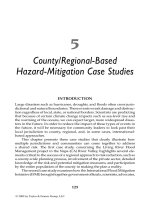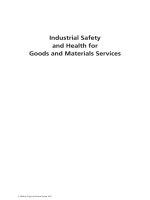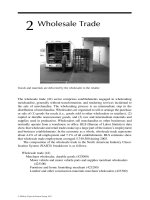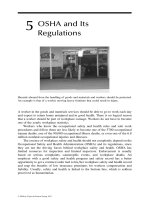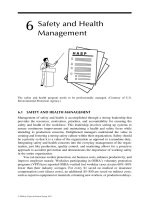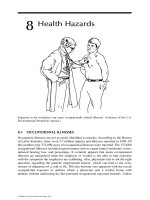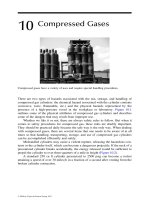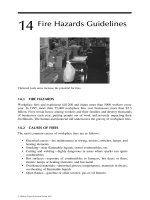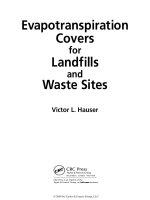Practical Design Calculations for Groundwater and Soil Remediation - Chapter 5 doc
Bạn đang xem bản rút gọn của tài liệu. Xem và tải ngay bản đầy đủ của tài liệu tại đây (279.67 KB, 44 trang )
Kuo, Jeff "Vadose zone soil remediation"
Practical Design Calculations for Groundwater and Soil Remediation
Boca Raton: CRC Press LLC,1999
©1999 CRC Press LLC
chapter five
Vadose zone soil remediation
This chapter illustrates important design calculations for commonly used in
situ and above-ground soil remediation techniques. The treatment processes
covered include soil vapor extraction, soil bioremediation, soil washing, and
low-temperature heating.
V.1 Soil vapor extraction
V.1.1 Introduction
Description of the soil venting process
Soil vapor extraction (SVE), also known as soil venting, in situ vacuum
extraction, in situ volatilization, or soil vapor stripping, has become a very
popular remediation technique for soil contaminated with VOCs. The process
strips volatile organic constituents from contaminated soil by inducing an
air flow through the contaminated zone. The air flow is created by a vacuum
pump (often called a “blower”) through a single well or network of wells.
As the soil vapor is swept away from the voids of the vadose zone, fresh
air is naturally (through passive venting wells or air infiltration) or mechan-
ically (through air injection wells) introduced and refills the voids. This flux
of the fresh air will (1) disrupt the existing partition of the contaminants
among the void, soil moisture, and soil grain surface by promoting volatil-
ization of the adsorbed and dissolved phase of contaminants, (2) provide
oxygen to indigenous microorganisms for biodegradation of the contami-
nants, and (3) carry away the toxic metabolic by-products generated from
the biodegradation process. The extracted air is usually laden with VOCs
and brought to the ground surface by the vacuum blower. Treatment of the
extracted vapor is normally required. Design calculations for the VOC-laden
air treatment are covered in Chapter seven.
©1999 CRC Press LLC
Major components of an SVE system
Major components of a typical soil venting system include vapor extraction
well(s), vacuum blower(s), moisture removal device (knock-out drum), off-
gas collection piping and ancillary equipment, and the off-gas treatment
system.
Important design considerations
The most important parameters for preliminary design are the extracted
VOC concentration, air flow rate, radius of influence of the venting well,
number of wells required, and size of the vacuum blower.
V.1.2 Expected vapor concentration
As mentioned in Section II.3.5, volatile organic contaminants in a vadose
zone may be present in four phases: (1) in the soil moisture due to dissolu-
tion, (2) on the soil grain surface due to adsorption, (3) in the pore void due
to volatilization, and (4) as the free product. If the free-product phase is
present, the vapor concentration in the pore void can be estimated from
Raoult’s law as
[Eq. V.1.1]
where
P
A
= partial pressure of compound
A
in the vapor phase,
P
vap
= vapor
pressure of compound
A
as a pure liquid, and
x
A
= mole fraction of com-
pound
A
in the liquid phase.
Examples using Raoult’s law can be found in Section II.3. The partial
pressure calculated from Eq. V.1.1 represents the upper limit of the contam-
inant concentration in the extracted vapor from a soil venting project. The
actual concentration will be lower than this upper limit because (1) not all
the extracted air passes through the contaminated zone and (2) limitations
on mass transfer exist. Nevertheless, this concentration serves as a starting
point for estimating the initial vapor concentration at the beginning of a
venting project. Initially the extracted vapor concentrations will be relatively
constant. As soil venting continues, the free product phase will disappear.
The extracted vapor concentration will then begin to drop, and the extracted
vapor concentration will become dependent on the partitioning of the con-
taminants among the three other phases. As the air flows through the pores
and sweeps away the contaminants, the contaminants dissolved in the soil
moisture will volatilize from the liquid into the void. Simultaneously, the
contaminants will also desorb from the soil grain surface and enter into the
soil moisture (assuming the soil grains are covered by a moisture layer).
Thus, the concentrations in all three phases decrease as the venting process
progresses.
PPx
A
vap
A
= ()()
©1999 CRC Press LLC
The above phenomenon describes common observations at sites that
contain a single type of contaminant. Soil venting has also been widely used
for sites contaminated with a mixture of compounds, such as gasoline. For
these cases, the vapor concentration decreases continuously from the start
of venting; a period of constant vapor concentration in the beginning phase
of the project does not exist. This can be explained by the fact that each
compound in the mixture has a different vapor pressure. Thus, the more
volatile compounds tend to leave the free product, as well as the moisture
and the soil surface, earlier and be extracted earlier. Table V.1.A shows the
molecular weights of fresh and weathered gasoline and their vapor pressures
at 20°C. The table also lists the saturated vapor concentrations that are in
equilibrium with the fresh and weathered gasoline.
To estimate the initial concentration of the extracted vapor in equilibrium
with the free-product phase, the following procedure can be used:
Step 1: Obtain the vapor pressure data of the compound of concern (e.g.,
from Table II.3.C).
Step 2: Determine the mole fraction of the compound in the free prod-
uct. For a pure compound, set
x
A
= 1. For a mixture, follow the
procedure in Section II.1.4.
Step 3: Use Eq. V.1.1 to determine the vapor concentration in atm or
mmHg unit.
Step 4: Convert the concentration by volume into a mass concentration,
if needed, by using Eq. II.1.1.
Information needed for this calculation
• Vapor pressure of the contaminant
• Molecular weight of the compounds
Example V.1.2A Estimate the saturated gasoline vapor
concentration
Use the information in Table V.1.A to estimate the maximum gasoline vapor
concentration from two soil venting projects. Both sites are contaminated
from accidental gasoline spills. The spill at the first site happened recently,
while the spill at the other site occurred 3 years ago.
Table V.1.A
Physical Properties of Gasoline and Weathered Gasoline
Molecular weight
(g/mole)
P
vap
@ 20°C
(atm)
G
est
Compound ppmV mg/L
Gasoline 95 0.34 340,000 1343
Weathered gasoline 111 0.049 49,000 220
Modified from Johnson, P. C., Stanley, C. C., Kemblowski, M. W., Byers, D. L., and
Colthart, J. D.,
Ground Water Monitor. Rev.,
Spring, 1990b. With permission.
©1999 CRC Press LLC
Solution:
a. The site with fresh gasoline. Vapor pressure of fresh gasoline is 0.34
atm at 20°C, as shown in Table V.1.A. The partial pressure of this
gasoline in the pore space can be found by using Eq. V.1.1. as:
P
A
= (
P
vap
)(
x
A
) = (0.34 atm)(1.0) = 0.34 atm
Thus, the partial pressure of gasoline in the air is 0.34 atm (= 340,000
×
10
–6
atm), which is equivalent to 340,000 ppmV. Use Eq. II.1.1 to
convert the ppmV concentration into a mass concentration unit (at
20°C), as
1 ppmV fresh gasoline = {(MW of fresh gasoline)/24.05} mg/m
3
= (95)/24.05 = 3.95 mg/m
3
So,
340,000 ppmV = (340,000)(3.95) = 1,343,000 mg/m
3
= 1343 mg/L
b. The site with weather
ed gasoline. Vapor pressure (as well as the
partial pressure in this case) of weathered gasoline is 0.049 atm, which
is equivalent to 49,000 ppmV. Use Eq. II.1.1 to convert the ppmV
concentration into a mass concentration unit (at 20°C), as
1 ppmV weathered gasoline
= {(MW of weathered gasoline)/24.05} mg/m
3
= (111)/24.05 = 4.62 mg/m
3
So,
49,000 ppmV = (49,000)(4.62) = 226,000 mg/m
3
= 226 mg/L
Discussion
1. The saturated vapor concentration of the weathered gasoline can be
a few times less than that of the fresh gasoline. (In this case, it is more
than five times smaller.)
2. The calculated vapor concentrations are essentially the same as those
listed in Table V.1.A.
3. Although gasoline is a mixture of compounds, the mole fraction was
set to one since the vapor pressure and molecular weight of gasoline
were given as the weighted averages.
Example V.1.2B Estimate saturated vapor concentrations of a
binary mixture
A site is contaminated with an industrial solvent. The solvent consists of
50% toluene and 50% xylenes by weight. Soil venting is considered for site
©1999 CRC Press LLC
remediation. Estimate the maximum vapor concentration of the extracted
vapor. The subsurface temperature of the site is 20°C.
Solution:
a.From Table II.3.C, the following physicochemical properties were ob-
tained: molecular weight = 92.1 (toluene) = 106.2 (xylenes) and
P
vap
=
22 mmHg (toluene) = 10 mmHg (xylenes).
b. The mole fraction of toluene in the solvent can be found as
basis = 1000 g solvent
moles of toluene = mass/MW = [(50%)(1000)] ÷ (92.1) = 5.43 moles
moles of xylenes = mass/MW = [(50%)(1000)] ÷ (106.2) = 4.71 moles
mole fraction of toluene = (5.43)/(5.43 + 4.71) = 0.536
mole fraction of xylenes = 1 – 0.536 = 0.464
c. The saturated vapor concentration can be found by using Eq. V.1.1 as
P
toluene
= (
P
vap
)(
x
A
) = (22 mmHg)(0.536) = 11.79 mmHg = 0.0155 atm
Thus, partial pressure of toluene = 0.0155 atm = 15,500 ppmV
P
xylenes
= (
P
vap
)(
x
A
) = (10 mmHg)(0.464) = 4.64 mmHg = 0.0061 atm
Thus, partial pressure of xylenes = 0.0061 atm = 6,100 ppmV.
The volumetric (or molar) composition of the extracted vapor =
(15,500)/[15,500 + 6100] = 71.8%
←
toluene.
d. The mass concentration can be found by using Eq. II.1.1 as
1 ppmV toluene = (92.1)/24.05 = 3.83 mg/m
3
So,
15,500 ppmV = (15,500)(3.83) = 59,400 mg/m
3
= 59.4 mg/L
1 ppmV xylenes = (106.2)/24.05 = 4.42 mg/m
3
So,
6100 ppmV = (6100)(4.42) = 27,000 mg/m
3
= 27.0 mg/L
The weight composition of the extracted vapor = (59.4)/[59.4 +27.0]
= 68.8%
←
toluene.
©1999 CRC Press LLC
Discussion
1. The toluene concentration in the extracted vapor is 68.8% by weight,
that is higher than its concentration in the liquid solvent, 50% by
weight. The higher percentage of toluene in the vapor is due to its
higher vapor pressure.
2. This saturated vapor concentration would be higher than the actual
concentration of the extracted vapor due to the fact (1) not all the air
flows through the contaminated zone and (2) limitations on mass
transfer exist.
As mentioned, the presence or absence of a free-product phase greatly
affects the extracted vapor concentration. To determine if the free-product
phase is present, the following procedure can be used:
Step 1: Obtain the physicochemical data of the compound of concern
(e.g., from Table II.3.C).
Step 2: Assume the free-product phase is present. Use Eq. V.1.1 to de-
termine the saturated vapor concentration in atm or mmHg unit.
Step 3: Convert the saturated vapor concentration into a mass concen-
tration by using Eq. II.1.1.
Step 4: Determine the
K
oc
value using Eq. II.3.14 and determine the
K
p
value using Eq. II.3.12.
Step 5: Determine the contaminant concentration in soil by using Eq.
II.3.23 and the vapor concentration from Step 3.
Step 6: If the contaminant concentration in soil determined from Step 5
is lower than the concentrations of the soil samples, the free-
product phase should be present.
Information needed for this calculation
• Vapor pressure of the contaminant
• Molecular weight of the compound
• Henry’s constant of the compound
• Organic water partition coefficient,
K
ow
• Organic content,
f
oc
• Porosity,
φ
• Degree of water saturation
• Bulk density of soil,
ρ
b
Example V.1.2C Determine if the free-product phase is present in
the subsurface
A subsurface is contaminated by a spill of 1,1,1-trichloroethane (1,1,1-TCA).
The TCA concentrations of the soil samples from the contaminated zone
were between 5000 and 9000 mg/kg. The subsurface has the following char-
acteristics:
©1999 CRC Press LLC
Porosity = 0.4
Organic content in soil = 0.02
Degree of water saturation = 30%
Subsurface temperature = 20°C
Bulk density of soil = 1.8 g/cm
3
Determine if the free-product phase of TCA is present in the subsurface.
What could be the maximum contaminant concentration in soil if the free-
product phase of TCA is absent?
Solution:
a.From Table II.3.C, the following physicochemical properties of 1,1,1-
TCA were obtained: Molecular weight = 133.4,
H
= 14.4 atm/M,
P
vap
= 100 mmHg, and Log
K
ow
= 2.49.
b. Use Eq. V.1.1 to determine the saturated TCA vapor concentration:
P
vap
= 100 mmHg = 0.132 atm = 132,000 ppmV
c. Convert the saturated vapor concentration into a mass concentration
by using Eq. II.1.1:
1 ppmV TCA = (133.4)/24.05 = 5.55 mg/m
3
So,
G
= 132,000 ppmV = (132,000)(5.55) = 733,000 mg/m
3
= 733 mg/L
d.Use Table II.3.B to convert the Henry’s constant to a dimensionless
value:
H*
=
H/RT
= (14.4)/[(0.082)(273 + 20)] = 0.60 (dimensionless)
Use Eq. II.3.14 to find
K
oc
,
K
oc
= 0.63
K
ow
= 0.63 (10
2.49
) = (0.63)(309) = 195
Use Eq. II.3.12 to find
K
p
,
K
p
= f
oc
K
oc
= (0.02) (195) = 3.9 L/kg
e. Use Eq. II.3.23 to estimate the soil concentration of TCA:
M
VH
K
H
G
t
w
b
p
a
=+ +
=++−
=
()
()
()
(.)( %)
.
(.)(.)
.
(.)( %)( )
φ
ρ
φ
04 30
060
18 39
060
0 4 1 30 733 8930 mg/L
©1999 CRC Press LLC
Divide the value by the bulk density of the soil to express the soil
concentration in mg/kg:
Soil concentration = 8930 mg/L ÷ 1.8 kg/L = 4960 mg/kg
This value, 4960 mg/kg, represents the maximum contaminant con-
centration in the soil if the free-product phase of TCA is absent.
f. Since the calculated TCA concentration, 4960 mg/kg, is less than those
of the soil samples, the free product phase of TCA should be present
in the subsurface.
To determine the extracted soil vapor concentration in the absence of
free-product in the subsurface, the following procedure can be used:
Step 1: Obtain the physicochemical data of the compound of concern
(e.g., from Table II.3.C).
Step 2: Determine the
K
oc
value using Eq. II.3.14 and determine the
K
p
value using Eq. II.3.12.
Step 3: Convert the contaminant concentration in soil from mg/kg to
mg/L.
Step 4: Determine the vapor concentration by using Eq. II.3.23 and the
contaminant concentration in soil from Step 3.
Information needed for this calculation
• Contaminant concentrations of soil samples
• Henry’s constant of the compound
• Organic water partition coefficient,
K
ow
• Organic content,
f
oc
• Porosity,
φ
• Degree of water saturation
• Bulk density of soil,
ρ
b
Example V.1.2D Estimate the extracted vapor concentration (in
the absence of the free-product phase)
A subsurface is contaminated by a benzene spill. The average benzene con-
centration of the soil samples, taken from the contaminated zone, was 500
mg/kg. The subsurface has the following characteristics:
Porosity = 0.35
Organic content = 0.03
Water saturation = 45%
Subsurface temperature = 25°C
Bulk density of soil = 1.7 g/cm
3
©1999 CRC Press LLC
Estimate the extracted soil vapor concentration at the start of the soil
venting project.
Solution:
a.From Table II.3.C, the following physicochemical properties of ben-
zene were obtained: molecular weight = 78.1,
H
= 5.55 atm/M,
P
vap
=
95.2 mmHg, and Log
K
ow
= 2.13.
b.Use Table II.3.B to convert the Henry’s constant to a dimensionless
value:
H* = H/RT
= (5.55)/[(0.082)(273 + 25)] = 0.23 (dimensionless)
Use Eq. II.3.14 to find K
oc
,
K
oc
= 0.63
K
ow
= 0.63 (10
2.13
) = (0.63)(135) = 85
Use Eq. II.3.12 to find K
p
,
K
p
= f
oc
K
oc
= (0.03)(85) = 2.6 L/kg
c. Multiply the concentrations of the soil samples by the bulk density
of the soil to express the soil concentration in mg/L:
Soil concentration = 500 mg/kg
×
1.7 kg/L = 850 mg/L
d. Use Eq. II.3.23 to estimate the soil vapor concentration of benzene in
equilibrium with this contaminant concentration in soil:
So,
G
= 42.3 mg/L = 42,300 mg/m
3
e. Convert the vapor concentration into a volume concentration by using
Eq. II.1.1:
1 ppmV benzene = (78.1)/24.5 = 3.2 mg/m
3
@ 25°C
42,300 mg/m
3
= 42,300 ÷ 3.2 = 13,200 ppmV
M
VH
K
H
G
G
t
w
b
p
a
=+ +
=++−
=
()
()
()
(. )( %)
.
(.)(.)
.
(. )( %)
φ
ρ
φ
035 45
023
17 26
023
0 35 1 45 850 mg/L
©1999 CRC Press LLC
Discussion.
The actual concentration of the extracted vapor would be
lower than 13,200 ppmV due to the fact that not all the air flows through
the contaminated zone and that limitations of mass transfer were not con-
sidered in the above calculations.
V.1.3 Radius of influence and pressure profile
Selecting the number and locations of vapor extraction wells is one of the
major tasks in design of in situ soil vapor extraction systems. The decisions
are typically based on the radius of influence (
R
I
), which can be defined as
the distance from the extraction well where the pressure drawdown is very
small (
P @ R
I
~ 1 atm). The most accurate and site-specific
R
I
values should
be determined from steady-state pilot testing. The pressure drawdown data
at the extraction well and the observation wells can be plotted as a function
of the radial distance from the extraction well on a semilog plot to determine
the
R
I
of that well. The approach is similar to the distance-drawdown method
for aquifer tests, as described in Section II.3.3. The
R
I
is commonly chosen
to be the distance where the pressure drawdown is less than 1% of the
vacuum in the extraction well.
The field test data can also be analyzed by using the flow equations,
which describe the subsurface air flow. The subsurface is usually heteroge-
neous, and the air flow through it can be very complex. As a simplified
approximation, a flow equation was derived for a fully confined radial gas
flow system in a permeable formation having uniform and constant prop-
erties.
3-6
References 3 through 6 are the basis for most of the sections on soil
venting.
For the steady-state radial flow subject to the boundary conditions (
P =
P
w
@
r
=
R
w
and
P = P
atm
@ r = R
I
), the pressure distribution in the subsurface
can be derived as
[Eq. V.1.2]
P
r
= pressure at a radial distance r from the vapor extraction well
P
w
= pressure at the vapor extraction well
P
RI
= pressure at the radius of influence (= atmospheric pressure or a
preset value)
r = radial distance from the vapor extraction well
R
I
= radius of influence where pressure is equal to a preset value
R
w
= well radius of the vapor extraction well
Eq. V.1.2 can be used to determine the R
I
of a vapor extraction well if
the pressure drawdown data of the extraction well and a monitoring well
(or data of two monitoring wells) are known. As shown, the flow rate and
the permeability of the formation are not included in this equation. The R
I
PP P P
rR
RR
r w RI w
w
w
22 2 2
1
−= −()
ln( / )
ln( / )
©1999 CRC Press LLC
can also be estimated from the vapor extraction rate and the pressure draw-
down data in the extraction well (see Section V.1.4).
If no pilot tests are conducted, an estimate is often made based on
previous experiences. The R
I
values ranging from 30 ft (9 m) to 100 ft (30 m)
are reported in the literature, and typical pressures in the extraction wells
range from 0.90 to 0.95 atm.
5
Shallower wells, less permeable subsurface,
and lower applied vacuum in the extraction well generally correspond to
smaller R
I
values.
Example V.1.3A Determine the radius of influence of a soil
venting well by using the pressure drawdown
data (pressure data are given in the
atmospheric unit)
Determine the radius of influence of a soil venting well with the following
information:
Pressure at the extraction well = 0.9 atm
Pressure at a monitoring well 30 ft away from the venting well = 0.98 atm
Diameter of the venting well = 4 in
Solution:
a. Let us define the R
I
as the location where P is equal to the atmospheric
pressure. The R
I
can be found by using Eq. V.1.2 as
R
I
= 118 ft
b. For comparison, let us now define the R
I
as the location where the
drawdown is equal to 1% of the vacuum in the extraction well. The
vacuum in the extraction well = 1 – 0.9 = 0.1 atm. Thus, P
RI
= 1 –
(0.1)(1%) = 0.999 atm.
R
I
= 110 ft
PP P P
rR
RR
r w RI w
w
Iw
22 2 2
−= −()
ln( / )
ln( / )
(. ) (.) (. . )
ln[ /( / )]
ln[ /( / )]
098 09 10 09
30 2 12
212
2222
−=−
R
I
(. ) (.) (. . )
ln[ /( / )]
ln[ /( / )]
098 09 0999 09
30 2 12
212
22 22
−= −
R
I
©1999 CRC Press LLC
Discussion. The R
I
value from (b), 110 ft, is about 7% shorter than that
from (a), and it is a more realistic value.
Example V.1.3B Determine the radius of influence of a soil
venting well by using the pressure drawdown
data (pressure data are given in inches
of water)
Determine the radius of influence of a soil venting well using the following
information:
Pressure at the extraction well = 48 in water vacuum
Pressure at a monitoring well 40 ft away from the extraction well = 8 in
water vacuum
Diameter of the vapor extraction well = 4 in
Strategy. The pressure data are expressed in inches of water. We need
to convert them to the atmospheric unit or convert the atmospheric pressure
to inches of water. A pressure of one atmosphere is equivalent to 33.9 feet
of water column.
Solution:
a. Pressure at the extraction well = 48” water vacuum = 33.9 – (48/12)
= 29.9 ft of water = (29.9/33.9) = 0.88 atm.
Pressure at the monitoring well = 8” water (vacuum) = 33.9 – (8/12)
= 33.23 ft of water = (33.23/33.9) = 0.98 atm.
b. Let us define the R
I
as the location where P is equal to the atmospheric
pressure. The R
I
can be found by using Eq. V.1.2 as
R
I
=128 ft
Example V.1.3C Estimate the pressure drawdown in a soil
venting monitoring well
Using the pressure drawdown data given in Example V.1.3B, estimate the
pressure drawdown (vacuum) in a monitoring well which is 20 ft away from
the extraction well.
Strategy. Example V.1.3B gives the pressure drawdown data at (1) the
monitoring well (P = 0.88 atm), (2) 40 ft away from the monitoring well (P
(. ) (. ) (. . )
ln[ /( / )]
ln[ /( / )]
098 088 10 088
40 2 12
212
2222
−=−
R
I
©1999 CRC Press LLC
= 0.98 atm), and (3) the R
I
(P = 1 atm). We can use any two of these three to
estimate the pressure drawdown in a well that is 20 ft away from the extrac-
tion well.
Solution:
a. First, use the data of the extraction well and the monitoring well (r =
40 ft). The pressure at the monitoring well (r = 20 ft) can be found by
using Eq. V.1.2 as
P
r
= 0.968 atm = 10.0 in. of water (vacuum)
b. We can also use the data of the extraction well and the R
I
. The pressure
at the monitoring well (r = 20 ft) can be found by using Eq. V.1.2 as
P
r
= 0.968 atm = 10.0 in. of water (vacuum)
c. We can also use the data of the monitoring well (r = 40 ft) and the R
I
.
The pressure at the monitoring well (r = 20 ft) can be found by using
Eq. V.1.2 as
P
r
= 0.968 atm = 10.0 in. of water (vacuum)
Discussion. All three approaches yield the same result.
V.1.4 Vapor flow rates
The radial Darcian velocity, u
r
, in homogeneous soil systems can be expressed
as
4
[Eq. V.1.3]
P
r
2222
088 098 088
20 2 12
40 2 12
−=−(. ) (. . )
ln[ /( / )]
ln[ /( / )]
P
r
2222
088 10 088
20 2 12
128 2 12
−=−(. ) (. . )
ln[ /( / )]
ln[ /( / )]
P
r
2222
098 10 098
20 40
128 40
−=−(. ) (. . )
ln[ / ]
ln[ / ]
u
k
P
rRR
P
P
P
P
rR
RR
r
w
wI
RI
w
RI
w
w
wI
=
−
+−
2
1
11
2
2
05
µ
ln( / )
ln( / )
ln( / )
.
©1999 CRC Press LLC
where u
r
is the vapor flow velocity at a radial distance “r” away from the
well. The velocity at the wellbore, u
w
, can be found by replacing r with R
w
in the above equation as
[Eq. V.1.4]
The volumetric vapor flow rate entering the extraction well, Q
w
, can then
be found as
[Eq. V.1.5]
where H is the perforation interval of the extraction well.
To convert the vapor flow rate entering the well to equivalent standard
flow rates, Q
atm
(where P = P
atm
= 1 atm), the following relationship can be
used
[Eq. V.1.6]
Example V.1.4A Estimate the extracted vapor flow rate of a soil
venting well
A soil venting well was installed at a site. Determine the radius of influence
of this soil venting well using the following information:
Pressure at the extraction well = 0.9 atm
Pressure at a monitoring well 30 ft away from the venting well = 0.95 atm
Diameter of the venting well = 4 in
Calculate the steady-state flow rate entering the well per unit well screen
length, vapor flow rate in the well, and the vapor rate at the extraction pump
discharge by using the following additional information:
Permeability of the formation = 1 Darcy
Well screen length = 20 ft
Viscosity of air = 0.018 centipoise
Temperature of the formation = 20°C
u
k
P
RRR
P
P
w
w
wwI
RI
w
=
−
2
1
2
µ ln( / )
QRuH
H
k
P
RR
P
P
www
w
wI
RI
w
=
=
−
2
1
2
π
π
µ ln( / )
Q
P
P
Q
atm
well
atm
well
=
©1999 CRC Press LLC
Strategy. We need to perform a few unit conversions first:
1 atm = 1.013 × 10
5
N/m
2
1 Darcy = 10
–8
cm
2
= 10
–12
m
2
1 poise = 100 centipoise = 0.1 N/s/m
2
So, 0.018 centipoise = 1.8 × 10
–4
poise = 1.8 × 10
–5
N/s/m
2
Solution:
a. The radius of influence of the venting well has been determined in
Example V.1.3A as 118 ft.
b. The radial air flow velocity at 20 ft away from the extraction well can
be found by using Eq. V.1.3:
c. The velocity at the wellbore, u
w
, can be found by using Eq. V.1.4:
u
k
P
rRR
P
P
P
P
rR
RR
r
w
wI
RI
w
RI
w
w
wI
=
−
+−
=
×
−
−
2
1
11
10
218 10
09 1013
2
2
05
12
5
µ
ln( / )
ln( / )
ln( / )
(. )
( . )( .
.
××
−
+−
=× −×− ÷
−
10
20 0 3048 2 12 118
1
1
09
11
1
09
20 2 12
2 12 206
2 78 10 2 28 10 0 2346 1
5
2
2
05
83
)
()(. )ln[(/)/ ] .
.
ln[ /( / )]
ln[( / )/ ]
( . )( . )( . ) ( .
.
1717
137 10
05
5
)
.
.
=×
−
m/s = 1.2 m/d
u
k
P
RRR
P
P
w
w
wwI
RI
w
=
−
=
×
×
−
−
−
2
1
10
218 10
0 9 1 013 10
2 12 0 3048 2 12 206
1
1
09
2
12
5
5
µ ln( / )
(. )
(.)(. )
( / )( . ) ln[( / )/ ] .
=× −×−
=×
−
−
2
85
3
2 78 10 2 73 10 0 2346
178 10
( . )( . )( . )
. m/s = 0.11 m/min = 154 m/d
©1999 CRC Press LLC
d. The vapor flow rate entering the well per unit screen interval can be
found by using Eq. V.1.5:
e. The vapor flow rate in the well = (0.035 m
3
/min/m)[(20 ft)(0.3048
m/ft)] = 0.21 m
3
/min = 7.4 ft
3
/min.
f. The vapor flow rate at the exhaust of the extraction pump can be
calculated from Eq. V.1.6:
Discussion. Using consistent units in Eqs. V.1.3 and V.1.5 is very
important. In the above calculations, the pressure is expressed in N/m
2
, the
distance in m, the permeability in m
2
, and the viscosity in N/s/m
2
. Conse-
quently, the calculated velocity is in m/s.
Example V.1.4B Estimate the radius of influence of a soil venting
well by using the extracted vapor flow rate
Determine the radius of influence of a soil venting well, with the following
information:
Pressure at the venting well = 0.7 atm
Flow rate measured at the extraction pump discharge = 0.21 m
3
/min
Well screen length = 5 m
Diameter of the venting well = 0.1 m
Permeability of the formation = 0.5 Darcy
Viscosity of air = 1.8 × 10
–4
poise
Temperature of the formation = 20°C
Strategy. This problem can be viewed as the reverse of Example V.1.4A
in which the radius of influence was given for estimation of the vapor
extraction flow rate. In this problem, the flow rate was given to estimate the
radius of influence. As in the previous example, a few unit conversions need
to be performed first:
1 atm = 1.013 × 10
5
N/m
2
Q
H
Ru
w
ww
=
==
2
2 2 12 0 3048 0 11 0 035
π
π[(/ )(. ) ](. /min) .m m m /min/m
3
Q
P
P
Q
atm
well
atm
well
=
=
=
09
1
021
.
(. )
0.19 m /min = 6.7 ft /min
33
©1999 CRC Press LLC
1 Darcy = 10
–8
cm
2
= 10
–12
m
2
1 poise = 100 centipoise = 0.1 N/s/m
2
So, 0.018 centipoise = 1.8 × 10
–4
poise = 1.8 × 10
–5
N/s/m
2
.
Solution:
a. The vapor flow rate entering the well can be found by using Eq. V.1.6:
b. The radius of influence can be found by using Eq. II.1.5:
R
I
= 31.9 m ≈ 32 m
Discussion. Using consistent units is critical for successful calculations
in this problem. Specifically, the flow rate is given in m
3
/min, but it needs
to be converted to m
3
/s to match the viscosity units in Eq. V.1.5.
V.1.5 Contaminant removal rate
The contaminant removal rate (R
removal
) can be determined by multiplying
the extracted vapor flow rate (Q) with the vapor concentration (G):
[Eq. V.1.7]
Care should be taken to have G and Q in consistent units, and G should
be in mass concentration units. Eq. V.1.1 can be used to estimate the initial
vapor concentration if the free-product phase is present, while the procedure
as illustrated in Example V.1.2C can be used to estimate the extracted vapor
concentration in the absence of the free-product phase. It is worthwhile to
note again that the calculated vapor concentrations from these procedures
Q
P
P
Q
atm
well
atm
well well
well
=
==
=
021
07
1
.
.
0.30 m /min = 0.005 m /s
33
Q
H
k
P
RR
P
P
R
w
w
wI
RI
w
I
=
=
−
=
×
×
×
−
−
−
0 005
5
1
05 10
18 10
0 7 1 013 10
005
1
1
07
2
12
5
5
.
ln( / )
(. )
.
(.)(. )
ln( . / ) .
π
µ
π
22
RGQ
removal
= ()()
©1999 CRC Press LLC
are the ideal and equilibrium values. The actual values should only be
fractions of these values, mainly due to the facts that the entire air stream
does not pass through the contaminated zone and that limitations of mass
transfer exist (the system will not reach equilibrium in most, if not all, cases).
Nevertheless, the calculated values provide useful information. One can
compare them with the actual data from sampling and establish the corre-
lation between them. The calculated data can then be calibrated, adjusted,
and used for later predictions.
For example, if we know that only a fraction η of the air flows through
the contaminated zone, Eq. V.1.7, should be modified as
[Eq. V.1.8]
The removal rate estimated from Eq. V.1.8 still represents the upper limit
of the vapor concentration because it does not consider mass transfer limi-
tations. The factor η can be considered as an overall efficiency factor if it
takes into account the percentage of flow through the contaminated zone
and the limitations of mass transfer.
The following procedure can be used to determine the contaminant
removal rate:
Step 1: Determine the extraction vapor flow rate from field measure-
ments or from the procedure described in Section V.1.4.
Step 2: Estimate the extracted vapor concentration using Eq. V.1.1 if the
free-product phase is present, while the procedure illustrated in
Example V.1.2C can be used to estimate the extracted vapor
concentration in the absence of the free-product phase.
Step 3: Convert the vapor concentration into a mass concentration by
using Eq. II.1.1.
Step 4: Adjust the calculated concentration from Step 2 by an overall
efficiency factor, η.
Step 5: Calculate the mass removal rate by multiplying the flow rate
(from Step 1) and the adjusted concentration (from Step 4).
Information needed for this calculation
• Extracted vapor flow rate, Q
• Extracted vapor concentration, G
• Overall efficiency factor relative to theoretical removal rate, η
Example V.1.5A Estimate the contaminant removal rate (in the
presence of free-product phase)
Recently, a gasoline spill occurred at a gasoline station and caused subsurface
contamination. A soil venting well was installed at the site for remediation.
RGQ
removal
= [( )( )]( )η
©1999 CRC Press LLC
The following data were obtained from the remedial investigation and a
pilot test:
Pressure at the extraction well = 0.9 atm
Pressure at a monitoring well 30 ft away from the venting well = 0.95 atm
Diameter of the venting well = 4 in
Permeability of the formation = 1 Darcy
Well screen length = 20 ft
Viscosity of air = 0.018 centipoise
Temperature of the formation = 20°C
Estimate the contaminant removal rate at the beginning of the project.
Solution:
a. The pressure drawdown data are the same as those in Example V.1.4A,
and the flow rate has been determined as 0.19 m
3
/min, or 6.7 ft
3
/min.
b. Assuming the free product phase is present, the saturated vapor con-
centration corresponding to the fresh gasoline is 340,000 ppmV, or
1343 g/m
3
(see Example V.1.2A). On the other hand, the saturated
vapor concentration corresponding to the weathered gasoline is
49,000 ppmV, or 226 g/m
3
.
c. Assuming the overall efficiency factor is equal to unity, the removal
rate can be found from Eq. V.1.8 as
R
removal
= [(η)(G)](Q) = [(1.0)(1343 g/m
3
)](0.19 m
3
/min)
= 255 g/min = 0.56 lb/min = 809 lb/d (for the fresh gasoline)
= [(1.0)(226 g/m
3
)](0.19 m
3
/min) = 42.9 g/min
= 0.095 lb/min = 136 lb/d (for the weathered gasoline)
Discussion. The extracted vapor flow rate in this example is relatively
small, at 6.7 ft
3
/min. However, the calculated theoretical removal rates, 809
lb/d for the fresh gasoline and 136 lb/d for the weathered gasoline, are
extraordinarily high. If the removal rate can be sustained at this level, the
site would be cleaned up in a matter of days. Unfortunately, this is not the
case. It normally takes months, if not longer, for a typical soil venting project
to reach completion. This example illustrates that the theoretical equilibrium
vapor concentration is higher than the practical values. For the case of
gasoline, which is a mixture of compounds, the removal rate will drop as
the more volatile ones leave the formation first (as indicated by the five
times lower removal rate of the weathered gasoline). However, the value
of 136 lb/d corresponding to the weathered gasoline is still on the high side
because the limitations of mass transfer were not included in this calcula-
tion. The removal rate should drop further after the free-product phase
disappears.
©1999 CRC Press LLC
Example V.1.5B Estimate the contaminant removal rate (in the
absence of the free-product phase)
A subsurface is contaminated with benzene. The average benzene concen-
tration of the soil samples, taken from the contaminated zone, was 500
mg/kg. The following data were obtained from the remedial investigation
and a pilot test:
Pressure at the extraction well = 0.9 atm
Pressure at a monitoring well 30 ft away from the venting well = 0.95 atm
Diameter of the venting well = 4 in
Permeability of the formation = 1 Darcy
Well screen length = 20 ft
Viscosity of air = 0.018 centipoise
Porosity = 0.35
Organic content = 0.03
Water saturation = 45%
Subsurface temperature = 25°C
Bulk density of soil = 1.7 g/cm
3
Estimate the contaminant removal rate at the beginning of the project.
Solution:
a. The pressure drawdown data are the same as those in Example V.1.4A,
and the flow rate has been determined as 0.19 m
3
/min, or 6.7 ft
3
/min.
b. The subsurface data are the same as those in Example V.1.2D, and the
extracted vapor concentration has been determined 42.3 mg/L, or 42.3
g/m
3
.
c. Assuming the overall efficiency factor is equal to one, the removal
rate can be found from Eq. V.1.8 as
R
removal
= [(η)(G)](Q) = [(1.0)(42.3 g/m
3
)](0.19 m
3
/min)
= 8.04 g/min = 11,600 g/d = 25.5 lb/d
Discussion. The estimated value of 25.5 lb/d is on the high side
because the overall efficiency factor is assumed to be unity. In addition, the
removal rate would drop because the contaminant concentration in the sub-
surface decreases as the venting project progresses.
V.1.6 Cleanup time
Once the contaminant removal rate is determined, the cleanup time (T
cleanup
)
can be estimated as
[Eq. V.1.9]
TMR
cleanup spill removal
= /
©1999 CRC Press LLC
where M
spill
is the amount of spill to be removed. M
spill
can be found by using
the equation below:
[Eq. V.1.10]
where X
initial
is the average initial contaminant concentration in soil, X
cleanup
is the soil cleanup level, M
s
is the mass of the contaminated soil, V
s
is the
volume of the contaminated soil, and ρ
b
is the bulk density of the soil. If the
cleanup level is very low compared to the initial contaminant concentration,
it can be deleted from Eq. V.1.10 as a factor of safety for design.
The above equations appear simple. However, the estimation of cleanup
time is complicated by the fact that the contaminant removal rate is changing.
The rate decreases as the amount of the contaminants left in the soil decreases.
One approach is to divide the cleanup into several time intervals. The removal
rate for each interval is determined and used to estimate the cleanup time
for each interval. The total cleanup can then be derived from summing the
cleanup time of each interval. The following steps detail this approach:
Step 1: Determine the maximum possible contaminant concentration in
soil in the absence of free-product, X
free-product
(see Example
V.1.2C). If the average concentration of the soil samples exceeds
this value, the free-product phase is present. Go to Step 2. If the
average concentration of the samples is smaller, the free product
phase is absent. Go to Step 5.
Step 2: Estimate the extracted vapor concentration using Eq. V.1.1 and
then calculate the mass removal rate using Eq. V.1.8.
Step 3: Determine the amount of contaminants to be removed before the
disappearance of the free product phase by using modified Eq.
V.1.10 as
[Eq. V.1.11]
Step 4: Determine the required time for removal of the free product by
using data from Steps 2 and 3 and Eq. V.1.9.
Step 5: Divide the (X
free product
– X
cleanup
) value into a few intervals. Use the
average X of each interval to estimate the vapor concentration
(see Example V.1.2D) and then calculate the mass removal rate
using V.1.8. If no free-product phase is present initially, replace
X
free product
with X
initial
in this step.
Step 6: Determine the amount of contaminants to be removed in each
interval by using modified Eq. V.1.10:
[Eq. V.1.12]
MXX MXX V
spill initial cleanup
S
initial cleanup
S
b
=− =−( )( ) ( )[( )( )]ρ
MXX M
XX V
removal initial free product
S
initial free product
S
b
=−
=−
−
−
()()
( )[( )( )]ρ
MXXMXXV
removal initial final
S
initial final
S
b
=− =−( )( ) ( )[( )( )]ρ
©1999 CRC Press LLC
The X
initial
and X
final
here are the beginning and the end concen-
trations of each interval, respectively.
Step 7: Determine the required cleanup time for each interval by using
data from Steps 5 and 6 and Eq. V.1.9.
Step 8: Sum the required time for each interval to calculate the total
cleanup time.
Information needed for this calculation
• Contaminant concentrations of soil samples
• Henry’s constant of the compound
• Organic water partition coefficient, K
ow
• Organic content, f
oc
• Porosity, φ
• Degree of water saturation
• Bulk density of soil, ρ
b
Example V.1.6A Estimate the cleanup time (in the presence of
free-product phase)
Recently, a gasoline spill occurred at a gasoline station and caused subsurface
contamination. A soil venting well was installed at the site for remediation.
The following data were obtained from the remedial investigation and a
pilot test:
Pressure at the extraction well = 0.9 atm
Pressure at a monitoring well 30 ft away from the venting well = 0.95 atm
Diameter of the venting well = 4 in
Permeability of the formation = 1 Darcy
Well screen length = 20 ft
Viscosity of air = 0.018 centipoise
Temperature of the formation = 20°C
Porosity = 0.35
Organic content in soil = 0.01
Degree of water saturation = 40%
Bulk density of soil = 1.8 g/cm
3
The size of the contaminant plume = 6500 ft
3
Initial average contaminant concentration in soil = 6000 mg/L
Required cleanup level = 100 mg/L
Overall efficiency factor relative to theoretical removal rate = 0.11
Estimate the required cleanup time.
Solution:
a. The pressure drawdown data are the same as those in Example V.1.4A,
and the flow rate has been determined as 0.19 m
3
/min, or 6.7 ft
3
/min.
©1999 CRC Press LLC
Presence of free-product phase
b. Determine the maximum possible contaminant concentration in the
soil in the absence of free-product, X
free-product
(use the procedure illus-
trated in Example V.1.2C). Since no Henry’s constant and K
ow
data are
available for gasoline, we use those of toluene, one of the common
gasoline components, as an approximation. Use Table II.3.B to convert
the Henry’s constant to a dimensionless value:
H* = H/RT = (6.7)/[(0.082)(273 + 20)] = 0.28 (dimensionless)
Use Eq. II.3.14 to find K
oc
:
K
oc
= 0.63K
ow
= 0.63 (10
2.73
) = (0.63)(537) = 338
Use Eq. II.3.12 to find K
p
:
K
p
= f
oc
K
oc
= (0.01) (338) = 3.4 L/kg
Use the saturated gasoline vapor concentration of weathered gasoline,
226 mg/L (from Example V.1.2A) and Eq. II.3.23 to estimate X
free-product
:
Divide this value by the bulk density of the soil to express the soil
concentration in mg/kg:
X
free-product
= 5100 mg/L ÷ 1.8 kg/L = 2830 mg/kg
c. Determine the amount of contaminants to be removed before the
disappearance of the free product phase by using Eq. V.1.11:
M
s
= (V
s
)(ρ
b
) = (6500 ft
3
)[(1.8 × 62.4 lb/ft
3
)]
= 730,100 lb = 332,000 kg
M
removal
= (X
initial
– X
free-product
)(M
s
) = (6000 – 2830 mg/kg)(332,000 kg)
= 9.40 × 10
8
mg = 940 kg
d. Estimate the extracted vapor concentration using Eq. V.1.1. As deter-
mined in Example V.1.2A, the saturated gasoline vapor concentrations
M
VH
K
H
G
t
w
b
p
a
=+ +
=++−
=
()
()
()
(. )( %)
.
(.)(.)
.
(. )( %)( )
φ
ρ
φ
035 40
028
18 34
028
0 35 1 40 226 5100 mg/L
©1999 CRC Press LLC
are 1343 mg/L and 226 mg/L for the fresh and the weathered gaso-
line, respectively. Since the observed VOC concentrations of the ex-
tracted vapor often decrease exponentially over time, the geometric
average of these two values is used as the average concentration for
this interval:
e. Calculate the mass removal rate using Eq. V.1.8:
R
removal
= [(η)(G)](Q) = [(0.11)(551 g/m
3
)](0.19 m
3
/min)
= 11.5 g/min = 16.6 kg/d
f. Determine the required cleanup time by using data from (c) and (e)
and Eq. V.1.9:
T
1
= M
removal
÷ R
removal
= (940 kg) ÷ 16.6 kg/d = 56.6 days
Absence of free-product phase
g. At the end of the free-product removal, the contaminant concentration
in soil is 2830 mg/kg, corresponding to a theoretical vapor concen-
tration of 226 mg/L. The cleanup level of soil for this project is 100
mg/kg. The average of 2830 and 100 is equal to 1465. To estimate the
required cleanup time, we divide it into two intervals. The first inter-
val is the time required to reduce the concentration from 2830 to 1465
mg/kg and the other is from 1465 to 100 mg/kg.
h. Determine the amount of contaminants to be removed in the first
interval by using Eq. V.1.12 as
M
removal
= (X
initial
– X
final
)(M
s
) = (2830 – 1465 mg/kg)(332,000 kg)
= 4.53 × 10
8
mg = 453 kg
For this interval the initial theoretical vapor concentration is 226 mg/L
(corresponding to 2830 mg/kg), the final theoretical vapor concentra-
tion (corresponding to 1465 mg/kg) can be easily found as
G
final
= 226 × (1465/2830) = 117 mg/L
The geometric average of these two is used as the average concentra-
tion for this interval:
Calculate the mass removal rate by using Eq. V.1.8:
G ==()()1343 226 551 mg/L
G ==()()226 117 163 mg/L
